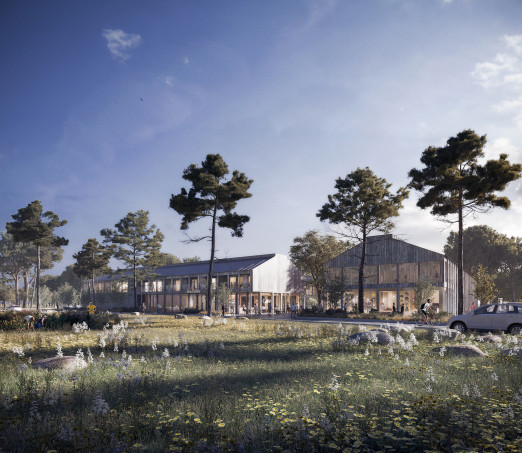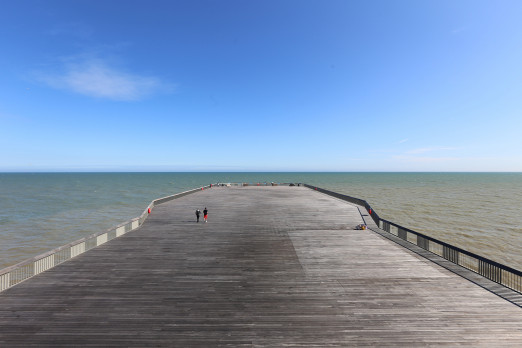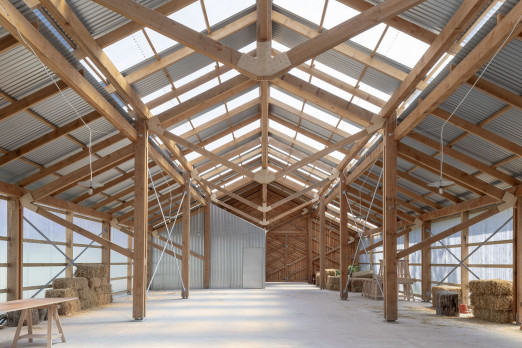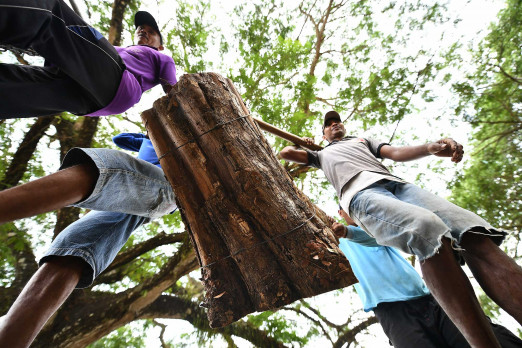Ahead of the opening of the Conversations about Climate Change exhibition we posed some pressing questions to David Hopkins, director of the Timber Trade Federation, to find out about FLEGT (the EU’s Forest Law Enforcement Governance and Trade Action Plan) and why it’s important.
Building Centre: Why are we encouraging the use of tropical timbers through the FLEGT Action Plan / and Conversations about Climate Change competition?
David Hopkins: We are not encouraging the uses of tropical timbers per say, but rather for people to understand where their materials come from and the impact, environmentally, that their choices can have. This is especially true when we look at products from tropical forest areas and countries. We want to make sure that the choices we make from these areas have a positive impact throughout the supply chain.
In our Conversations about Climate Change design competition, we are showcasing tropical hardwood species from countries that have signed a Voluntary Partnership Agreement (VPA), with aspirations towards achieving a FLEGT-licensed for their timber and timber products. This involves this introduction of country-specific, strong legal and governance framework within each country - to ensure that forests are managed according to appropriate laws and practices. It helps eradicate illegal logging and related illegal activity, to ensure forests are managed for the benefits of all.
Wouldn’t it be more environmentally friendly just to leave the land alone? Vanessa Norwood, Creative Director of the Building Centre
DH: The idea of ‘leaving the land alone’ is an admirable concept, but one which would never work. The reality is that there are multiple and competing pressures on land and land use. Principally from agriculture, mining, and the need to feed a growing population - we need to balance the demand for material and food with the need to keep these incredible habitats standing, in order to regulate the earth’s atmosphere.
Globally, the main driver of deforestation is clearance for agriculture. A 2018 study cited by Forest Trends, estimated that 51% of global tree cover loss between 2000 and 2015 was due to agriculture. These agricultural products include cattle products, soy, and palm oil and with lower global but important local impacts, cocoa, coffee, sugar, and rubber. A 2014 study approximated that 49% of tropical deforestation between 2000 and 2012 was due to illegal conversion of forests for commercial agriculture, with nearly one quarter a direct result of illegal conversion to agriculture for export markets.
Forms of land use, like agriculture and mining etc. are reliant on clearing trees to create space for crops and other activities. Timber production relies on trees to be standing for continuation. Tropical forests are of exceptional importance for climate and emissions reductions, leading to climate change mitigation strategies.
Timber production, under sustainable forest management practices, is one of the best ways to keep the trees and habitats standing while also providing a viable income for the local communities, along with other ecosystem benefits and services. By providing a renewable, sustainable income, local communities are not reliant on other forms of income, like the illegal wildlife trade.
Through our Conversations about Climate Change competition, exhibition, and event series, we are showing that timber harvesting from sustainable forest management sources will actually keep the forests standing – provided governance and legal reforms are in place. We can support this by keeping trade alive and money flowing back to those making the positive changes through their country Voluntary Partnership Agreement (VPA).
How does FLEGT and other international licensing standards provide greater insight to the actual supply chain - from forest to gate - of the lumber we purchase? Kelly Alvarez Doran, OAA, RAIC at Mass Design Group
DH: The EU Forest Law Enforcement Governance and Trade (FLEGT) Action Plan increases transparency, accountability, and oversight along the entire supply chain – from forest floor to manufacturer to end-user. Before FLEGT licenses are granted and issued to timber or timber products in a Voluntary Partnership Agreement (VPA) country, independent auditors and authorities ensure that timber has been legally harvested from legal sources. This process is conducted through verification of unambiguous evidence that timber and related activities comply with the requirements set out in that countries VPA, meeting their legality definition. Evidence is verified at different stages along the supply chain through gathering physical checks and documentation, information and/or data systemically collected. Verification of legality can be through government agencies, market participants, third-party organisations, or any combination of these groups. After achieving FLEGT licensing status, an independent auditor regularly checks and reports on implementation, effectiveness, and potential shortcomings of verifications.
Greater insight through improved supply chain transparency, enables the partner VPA country to make information available for public scrutiny to improve transparency and accountability. This disclosure of information strengthens governance in the forest sector and enables implementation of a countries VPA to be monitored. This further enables reports on effectivities and potential shortcomings to be flagged up and confronted. In this respect, a countries VPA increases transparency: underpinning legality, accountability, legal clarify and participation; reinforces credibility and limits opportunities for corruption. The benefits extend further to creating scrutiny for the forestry sector and enable rights and responsibilities for forest stakeholders.
What is the difference between FLEGT and the FSC? Harriet Jennings, public programme curator, the Building Centre
DH: Certification schemes such as FSC (Forest Stewardship Council) or PEFC (Programme for the Endorsement of Forest Certification) and FLEGT (the EU’s Forest Law Enforcement Governance and Trade Action Plan) have their strengthens and weakness – and synergies between the schemes would be useful to help overcome obstacles where certification falls short.
The first difference between FSC and FLEGT relates to permanence. Natural forests are often owned by the state, which allocates time-limited harvesting rights to private sector management through concessions. There is therefore no incentive for forest managers to commit to long-term sustainability targets if they do not own the land or if their rights extend to a single harvest. This means a different company who do not choose to uphold the same voluntary standard may replace individual certification brands, and therefore certification brands, such as FSC, may not have a permanent impact. FLEGT, on the other hand, takes place on a state level.
The second is land tenure conflicts: state ownership of natural forest is often contested. Lack of recognition of community tenure rights is often the basis of conflicts and violence, which is difficult to address through certification. Government processes and FLEGT Voluntary Partnership Agreements are better suited to address this injustice. Legal reform concerning the ‘affirmation of local forest tenure and of different stakeholder rights’ can be engrained in a countries Voluntary Partnership Agreement, as is demonstrated in Ghana and Liberia.
A third difference relates to scale. Certification is applied to individual forest concessions contrasted by a countrywide implementation. Certification raises the standards for that particular concessional area but has no impact on the wider forest estate.
In Indonesia, FLEGT / SVLK meets around 60% of the requirements of FSC, and in Ghana, the FLEGT Voluntary Partnership Agreement process meets fully or partially address 75% of the criteria in FSC standards (Asosiasi Pengusaha Hutan Indonesia; Proforest).
How can you decrease the desirability of particularly threatened and rare species by increasing the desirability of more sustainably species? Tom Svilans, PhD researcher, engineered timber construction
DH: There have been a lot of efforts to promote the use of Lesser Known Timber Species (LKTS). This would help elevate pressure on timber stocks and increase biodiversity within forests. One of the ways to do this is to educate specifies about the range of species available, where they come from and what their design properties are – so that they are able to make those informed choices and start to increase demand across the full palette of species available. Promoting trade with Voluntary Partnership Agreement (VPA) countries will encompass an increased availability and greater understanding of some of the lesser known species, of which will increase the desirability of more sustainable species. Lesser known timber species (LKTS) ‘are the untapped potential of the timber world – environmentally, socially and economically’ (FSC).
Becoming a Voluntary Partnership Agreement (VPA) partner is voluntary and only relates to tropical timber trade with the EU. Is there a risk that VPA countries still trade illegally logged timber to non-EU countries? And if tackling illegal logging and deforestation is the priority, how can the FLEGT Action Plan engage with countries that have illegal logging linked to political corruption? Mathilde Savary, public programme curator, the Building Centre
DH: A Voluntary Partnership Agreement (VPA) is a legally binding trade agreement between the European Union and a timber-producing country outside of the EU. Setting a definition of ‘legal timber’, based on laws and regulations of the partner country and implementing relevant laws, which encompass: land and community rights, payment of fees, environmental protection, and logging rules works to ensure that the partner country’s social, economic and environmental objectives are being met.
Each VPA is underpinned by a strong, regimented timber legality assurance system (TLAS). This system allows the timber-exporting country to verify that the timber and timber products are sourced and produced legally. While this is an enormous benefit to operators in Europe - as FLEGT licensed timber is verified as legal and therefore does not require further due diligence to be conducted - it is also an added benefit to all other countries that trade with the VPA country. Once a country achieves FLEGT status, this is applicable for all timber and timber products exported from this country.
Addressing political corruption is one of the main challenges for the continuation of the FLEGT Action Plan. Actively promoting the rule of law and strengthening participation of civil society organisations as well as local communities is the only way to tackle forest crimes, bribery, and collusion.
Conversations about Climate Change is a partnership between the Building Centre and the Timber Trade Federation. Supported by the Foreign, Commonwealth & Development Office and The Built Environment Trust. The exhibition opens on 19 November, with an associated events programme.











